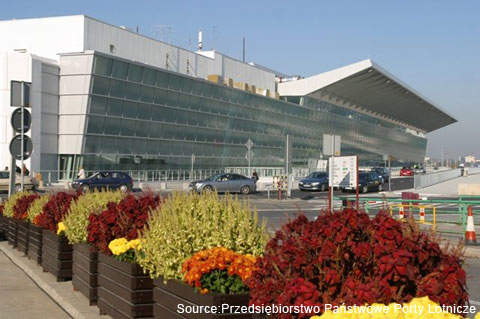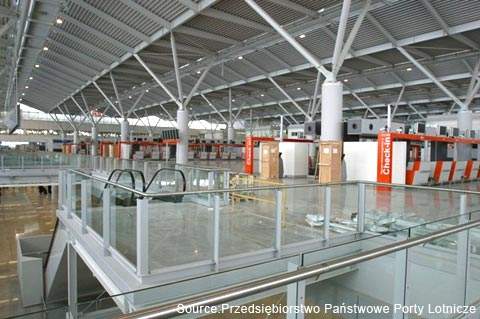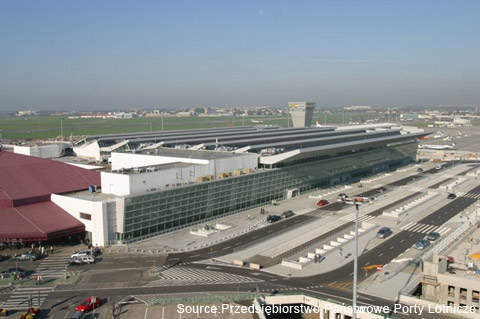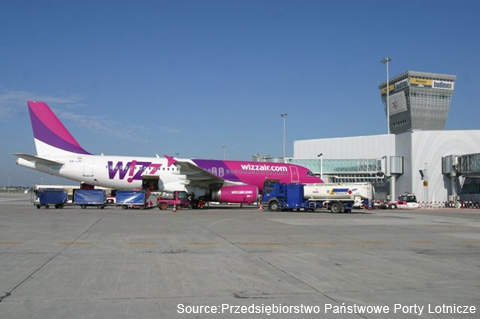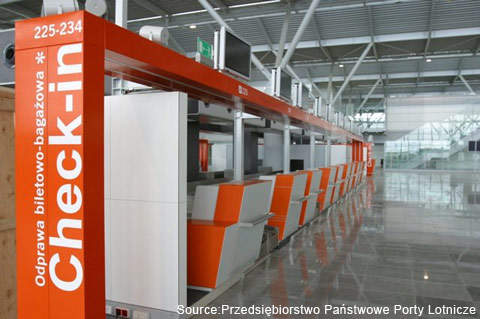Frederic Chopin International Airport, which first opened in 1969, is situated 10km south-west of Warsaw, Poland, on a 500ha site. The airport is operated and managed by Przedsiębiorstwo Państwowe Porty Lotnicze (PPL).
The airport is named after the Polish composer, but was formerly known as Okecie Airport. It is the busiest airport in Poland and handles around 50% of the country’s air passenger traffic.
Frederic Chopin airport was declared winner of the Airports Conference 2011. The airport also won the Pearl of the Polish Economy award, given by Polish Market magazine, for the third time, and was given the Institute of Economics Polish Academy of Sciences award.
The airport has two intersecting runways: 11/29, which is 2,800m2 (9,186ft2) long and 50m wide, and 15/33, which is 3,689m2 long and 60m wide. It also has 21 taxiways, and this infrastructure allows 34 operations an hour.
The airport handled over 9.2 million passengers in 2011, an increase of 7.2% on 2010.
Capacity increase
Foreseeing an increase in passenger traffic, PPL instigated a €190m expansion plan in 2004. The project took the form of a new terminal (terminal 2), which was integrated into the design of the older terminal.
The arrivals hall, which was built in the 1970s, w "Frederic Chopin Airport is named after the Polish composer."as renovated and reopened in 2005 as a low-cost traffic terminal, but was closed in March 2009. The carriers were moved to terminal 1.
Terminal 1 (T1) has a capacity of 3.5 million passengers a year, but the new terminal (T2) has increased the airport’s overall capacity to ten million passengers a year in the first phase. This will boosted to 12 million in phase II of the expansion project.
T1, which was built in 1992, is now used for low-cost airlines. Plans to renovate and remodel the old part of airport will take place after the UEFA Euro 2012 football championships for completion by the end of 2014.
Other projects include improvements to the access road, apron parking and runway lighting, as well as a new 9,400-space car park. Skanska completed the renovation of the parking apron and taxiway in November 2011. The reconstruction of intersection runways was completed in September 2010.
Frederic Chopin airport terminal 2 construction
In May 2004, construction work began on Frederic Chopin International Airport’s new T2. The general construction contract was awarded to Ferrovial Agroman, Budimex and Estudio Lamela (the consortium was also responsible for the terminal’s design and architecture).
T2 became fully operational in March 2008 and can handle 6.5 million passengers a year. The building has an arrivals area, a departures hall and three concourses designated south, north and central.
The two-storey terminal was first constructed in 1992 and was given a new lease of life with the remodelling and construction of the adjoining T1. The two terminals share the same roof.
Other building work has included a new VIP pavilion and an underground station for the suburban train linking the airport with the centre of Warsaw.
Terminal 2 setback
The construction of T2 added over 94,000m2 of floor space and opened in November 2007.
Frederic Chopin International Airport’s arrivals hall opened in December 2006 (and is in use for the entire airport), however the departures hall and north concourse failed their fire safety inspection and were unable to open.
In October 2007, operator PPL, after the second failed fire inspection, dismissed the building consortium and parts of the departures hall and north concourse were left unfinished. The terminal’s full operations were delayed for two years from the original planned opening date.
T2 also provided 70 normal check-in desks, ten hand-luggage check-in desks, six self-check-in, two oversized-luggage check-in and one VIP check-in. There are 44 gates at T2.
Two new piers central and south were inaugurated at the airport in August 2011, increasing the terminal space.
Frederic Chopin airfield improvements
The airfield improvements were undertaken by an ADB and Siemens consortium. The contract had a value of zl6.52m (€1.6m) and involved the modernisation of three parking areas for aircraft and the construction of a new plane parking area near T2.
Another addition was the improvement of runway safety by the installation of the 1,300 CAT III taxiway apron lights and 51 guidance signs. The installation will be completed in 2013. The new lights and installations had been integrated into the existing light control and monitoring system. The project was divided into four phases and the first three were completed by the end of 2007.
Road and rail infrastructure
Warsaw city centre has day-time bus services to Frederic Chopin International Airport on lines 188 and 175, and night services on line N32. An additional line near Warsaw, line 148, provides access to Ursynów.
Below terminal T2, a train station – which will connect the airport to Warszawa Sródmiescie station – is under construction. The zl230m (€58m) project started in October 2009 and will open in the last quarter of 2012. The nearest station to the airport is Okecie, which connects to downtown Warsaw.
Future development
In September 2011, ALPINE decided to build a five-star hotel at Frederic Chopin International Airport, which will be completed by mid-2013. About $36.4m was released for the renovation and construction works.
A new baggage handling improvement programme, construction of a bus terminal and a rail link project are some of the planned future developments.

